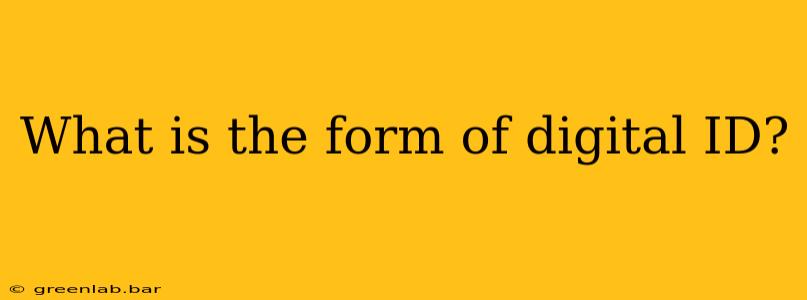The term "digital ID" might conjure images of futuristic sci-fi, but it's very much a present-day reality, rapidly evolving to become an integral part of our increasingly digital lives. Instead of a single form, digital identity encompasses a broad spectrum of technologies and approaches, each with its own strengths and weaknesses. Understanding these different forms is crucial for navigating the complex world of online security and verification.
Types of Digital Identity: A Detailed Overview
Digital IDs are not a monolithic entity. They come in various shapes and sizes, broadly categorized as follows:
1. Username and Password: The Traditional Approach (and its limitations)
This is the most familiar form, albeit the least secure. It relies on a username and a password to authenticate a user's identity. While simple to implement, its vulnerability to hacking and phishing makes it inadequate for high-security applications. The ease of password reuse across multiple platforms further exacerbates this risk.
Limitations: Susceptible to brute-force attacks, easily phishable, and prone to human error (weak passwords).
2. Multi-Factor Authentication (MFA): Adding Layers of Security
MFA enhances the basic username/password system by requiring multiple forms of verification. This might include a one-time code sent via SMS, an authenticator app, or a biometric scan. Adding these extra layers significantly strengthens security by making it considerably harder for unauthorized access.
Strengths: Increased security, reduces the risk of unauthorized access, protects against phishing attacks.
3. Digital Certificates: Trust and Encryption
Digital certificates are electronic documents that verify the identity of websites and individuals. They are based on public key cryptography, providing encryption and authentication for secure communication. Websites using HTTPS often rely on digital certificates to establish trust with users. Similarly, digital signatures use certificates to validate the authenticity of documents and transactions.
Strengths: Strong authentication, encryption for secure communication, widely used for secure online transactions.
4. Biometric Authentication: Leveraging Unique Physical Traits
Biometric authentication uses unique biological traits like fingerprints, facial recognition, or iris scans to verify identity. This method offers high security as it's incredibly difficult to replicate someone's biometric data. However, concerns regarding privacy and data security remain.
Strengths: High security, difficult to replicate, convenient and user-friendly in many applications. Weaknesses: Privacy concerns, potential for errors in identification, vulnerability to spoofing in certain cases.
5. Decentralized Identifiers (DIDs): The Future of Digital Identity?
DIDs represent a paradigm shift in how digital identity is managed. They rely on blockchain technology, offering greater control and security to individuals over their own data. DIDs enable users to selectively share verified attributes without revealing their complete identity. This approach aligns with growing demands for increased privacy and data ownership.
Strengths: Increased user control, enhanced privacy, improved security through decentralized architecture. Weaknesses: Relatively new technology, still undergoing development and standardization.
The Future of Digital ID: Trends and Considerations
The landscape of digital identity is constantly evolving. We can expect to see continued innovation in areas like:
- Improved security protocols: Addressing vulnerabilities in existing systems and developing more robust authentication methods.
- Enhanced privacy protection: Balancing the need for security with individual rights to privacy and data control.
- Interoperability: Enabling seamless exchange of digital identity information across different platforms and systems.
- Wider adoption of decentralized identifiers: Gradually transitioning towards more user-centric and privacy-preserving identity management.
Understanding the different forms of digital ID is critical for both individuals and organizations. As we increasingly rely on digital systems, choosing the right type of digital identity becomes paramount for ensuring security, privacy, and trust in the digital world.

